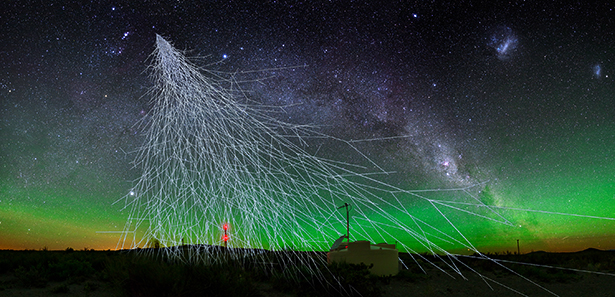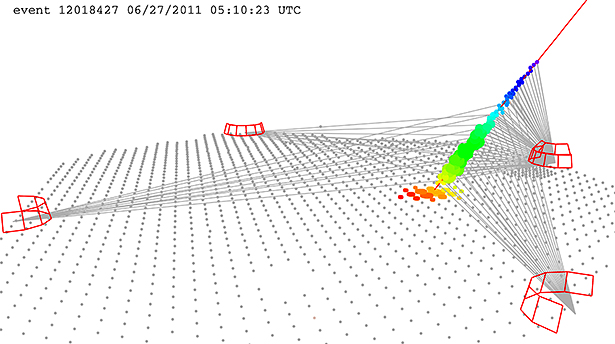Cosmic radiation is partially extragalactic
Directional asymmetry provides clues to the still mysterious origins
Not from this galaxy: For over 50 years, astronomers have been puzzling where the extremely energetic part of the cosmic radiation comes from. Now there is a first hint. Measurements of the Pierre Auger Observatory in Argentina show that this extreme radiation is distributed asymmetrically. It seems to come primarily from a certain direction of the universe - and this points to an extragalactic origin, as the researchers in the specialist magazine "Science" report.

Where does the most energetic part of the cosmic radiation come from? The Pierre Auger observatory has found the first clues. © Pierre Auger ObservatoryOur Earth is constantly bombarded by cosmic rays. However, where this rain of energetic, charged particles comes from has only been clarified in parts so far. Thus particles with lower energies seem to emanate from the sun, neighboring stars and also from the center of the Milky Way. This radiation is also released in Supernovae.
However, puzzling remains where the source of the most energetic part of the cosmic radiation lies. These particles rush with energy of more than eight Exa-Electronvolts (EeV) through space - about one million times more than the particles in the Large Hadron Collider (LHC), the world's strongest particle accelerator. Because these fly with "only" around eight Tera-Elektronvolts through the ring.
Mysterious origin
The existence of cosmic radiation with such ultra-high energies has been known for about 50 years, but the locations and mechanisms of their production are still a mystery, the researchers of Pierre Auger Collaboration explain.
One of the reasons: this extreme radiation is rare. Each year, only one particle per square kilometer hits the earth's atmosphere. There it collides with gas particles and produces a downward spreading shower of secondary particles.
But there is another problem: both the magnetic field of our Milky Way and interstellar fields direct the charged particles from their original trajectory. Therefore, the astronomers can not directly determine their origin. If, however, the directional distribution of many such highly energetic particles is determined, then this can at least reveal whether the sources are distributed evenly in space, or whether the most energetic cosmic radiation comes increasingly from one direction.
Water tanks and telescopes

In the tanks of the observatory, each filled with twelve tons of water, the cosmic radiation produces minute flashes of light. © The Pierre Auger ObservatoryThis is exactly what the researchers have achieved with the Pierre Auger Observatory in Argentina. The facility consists of 1,600 water tanks spread over an area of 3,000 square kilometers. If secondary particles of the cosmic radiation collide with the water molecules, this produces flashes of light, the so-called Chernkov radiation. From the nature of these flashes, the trajectory and energy of the cosmic radiation can be reconstructed.
Four telescopes additionally record the fluorescence that the radiation generates during its passage through the earth's atmosphere. This weak light is generated because the particles transfer energy to the air particles during their collisions, which expose this excess energy as light. Through this combination of detectors, the Auger Observatory has captured around 30,000 cases of cosmic radiation in the last twelve years, providing astronomers with an insight into where the most energetic cosmic radiation comes from.
Not from our galaxy
The surprising result: while the cosmic radiation of lower energies is coming uniformly from all directions, this is not the case with the highly energetic particles. The astronomers registered a slight but significant asymmetry in the directional data of the extreme radiation. Thus, especially many particles come from a sky field that is 90 degrees away from the galactic center and contains many galaxies. As early as 2014, a detector in the US had discovered a similar asymmetry, but this was based on much less events.

Observed by the Auger-Observaotrium with a particle-viewer of cosmic radiation © The Pierre Auger ObservatoryAccording to astronomers, the results suggest that this radiation does not come from our Milky Way.
The magnitude and direction of this anisotropy support the hypothesis that the most energetic cosmic radiation is extragalactic, the researchers said.
Thus, they have succeeded in isolating the origin of this enigmatic extreme radiation at least.
Sources still puzzling
However: What generates these high-energy particle streams is still open.
The particles we register are so energetic that they have to come from extremely violent events, says Gregory Snow of the Pierre Auger Collaboration.
The astronomers suggest, for example, that the massive black holes in the heart of remote galaxies could produce this cosmic radiation.
There are indications that the very active black holes of some galaxies can accelerate particles to very high energies, explains Snow.
He and his colleagues hope that a current upgrade of the Auger observatory will help them to solve the problem of their origin. The upgrade is intended to further improve the precision with additional detectors and improved evaluation technology.
Source: Science, 2017; doi: 10.1126 / science.aan4338

This wonderful post has received a bellyrub of 1.02 % upvote from @bellyrub thanks to this cool cat: @n3bul4. My pops @zeartul is one of your top steemit witness, if you like my bellyrubs please go vote for him, if you love what he is doing vote for this comment as well.
This post has received a 0.35 % upvote from @drotto thanks to: @banjo.
This post has received a 0.97 % upvote from @booster thanks to: @n3bul4.
@n3bul4 got you a $1.38 @minnowbooster upgoat, nice! (Image: pixabay.com)
Want a boost? Click here to read more!
Resteemed your article. This article was resteemed because you are part of the New Steemians project. You can learn more about it here: https://steemit.com/introduceyourself/@gaman/new-steemians-project-launch